英语翻译转换法共48页
- 格式:ppt
- 大小:8.05 MB
- 文档页数:48
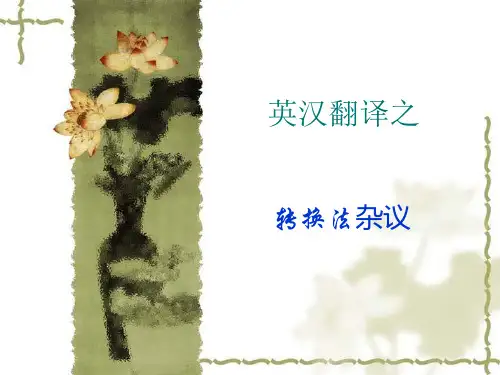
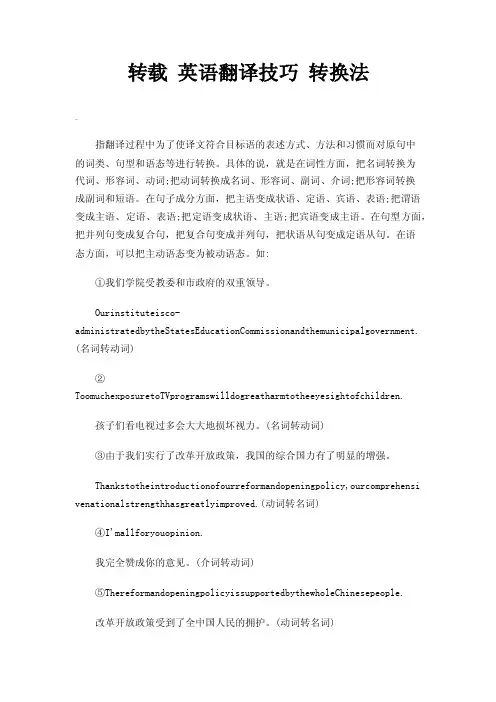
转载英语翻译技巧转换法指翻译过程中为了使译文符合目标语的表述方式、方法和习惯而对原句中的词类、句型和语态等进行转换。
具体的说,就是在词性方面,把名词转换为代词、形容词、动词;把动词转换成名词、形容词、副词、介词;把形容词转换成副词和短语。
在句子成分方面,把主语变成状语、定语、宾语、表语;把谓语变成主语、定语、表语;把定语变成状语、主语;把宾语变成主语。
在句型方面,把并列句变成复合句,把复合句变成并列句,把状语从句变成定语从句。
在语态方面,可以把主动语态变为被动语态。
如:①我们学院受教委和市政府的双重领导。
Ourinstituteisco-administratedbytheStatesEducationCommissionandthemunicipalgovernment. (名词转动词)②ToomuchexposuretoTVprogramswilldogreatharmtotheeyesightofchildren.孩子们看电视过多会大大地损坏视力。
(名词转动词)③由于我们实行了改革开放政策,我国的综合国力有了明显的增强。
Thankstotheintroductionofourreformandopeningpolicy,ourcomprehensi venationalstrengthhasgreatlyimproved.(动词转名词)④I'mallforyouopinion.我完全赞成你的意见。
(介词转动词)⑤ThereformandopeningpolicyissupportedbythewholeChinesepeople.改革开放政策受到了全中国人民的拥护。
(动词转名词)⑥Inhisarticletheauthoriscriticalofman'snegligencetowardhisenvironment.作者在文章中,对人类疏忽自身环境作了批评。
(形容词转名词)⑦InsomeoftheEuropeancountries,thepeoplearegiventhebiggestsocialbenefit ssuchasmedicalinsurance.在有些欧洲国家里,人民享受最广泛的社会福利,如医疗保险等。
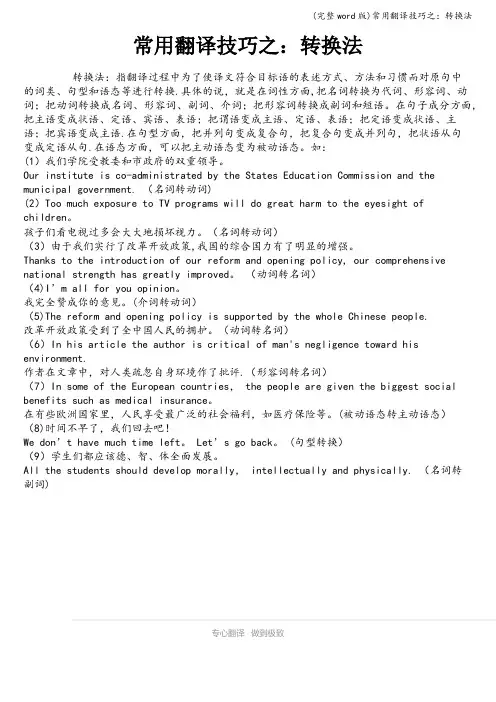
(完整word版)常用翻译技巧之:转换法常用翻译技巧之:转换法转换法:指翻译过程中为了使译文符合目标语的表述方式、方法和习惯而对原句中的词类、句型和语态等进行转换.具体的说,就是在词性方面,把名词转换为代词、形容词、动词;把动词转换成名词、形容词、副词、介词;把形容词转换成副词和短语。
在句子成分方面,把主语变成状语、定语、宾语、表语;把谓语变成主语、定语、表语;把定语变成状语、主语;把宾语变成主语.在句型方面,把并列句变成复合句,把复合句变成并列句,把状语从句变成定语从句.在语态方面,可以把主动语态变为被动语态。
如:(1)我们学院受教委和市政府的双重领导。
Our institute is co-administrated by the States Education Commission and the municipal government. (名词转动词)(2)Too much exposure to TV programs will do great harm to the eyesight of children。
孩子们看电视过多会大大地损坏视力。
(名词转动词)(3)由于我们实行了改革开放政策,我国的综合国力有了明显的增强。
Thanks to the introduction of our reform and opening policy, our comprehensive national strength has greatly improved。
(动词转名词)(4)I’m all for you opinion。
我完全赞成你的意见。
(介词转动词)(5)The reform and opening policy is supported by the whole Chinese people.改革开放政策受到了全中国人民的拥护。
(动词转名词)(6)In his article the author is critical of man's negligence toward his environment.作者在文章中,对人类疏忽自身环境作了批评.(形容词转名词)(7)In some of the European countries, the people are given the biggest social benefits such as medical insurance。
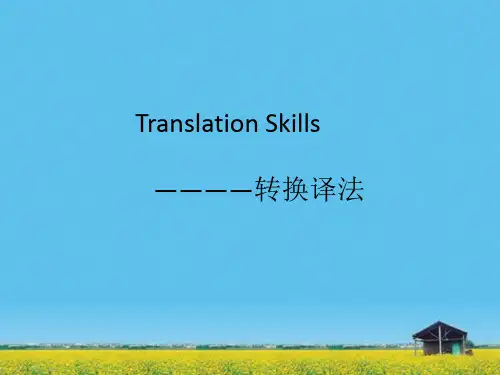
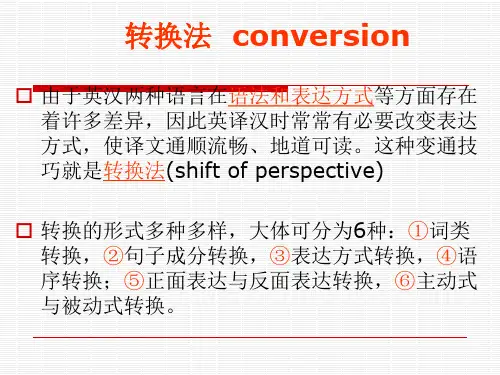

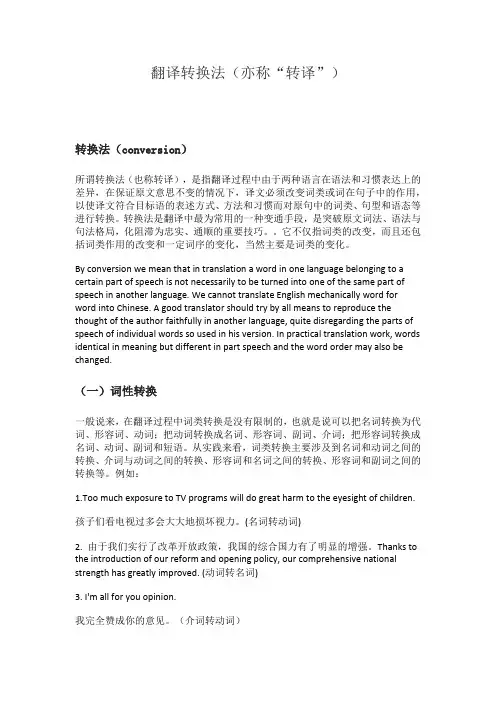
翻译转换法(亦称“转译”)转换法(conversion)所谓转换法(也称转译),是指翻译过程中由于两种语言在语法和习惯表达上的差异,在保证原文意思不变的情况下,译文必须改变词类或词在句子中的作用,以使译文符合目标语的表述方式、方法和习惯而对原句中的词类、句型和语态等进行转换。
转换法是翻译中最为常用的一种变通手段,是突破原文词法、语法与句法格局,化阻滞为忠实、通顺的重要技巧。
它不仅指词类的改变,而且还包括词类作用的改变和一定词序的变化,当然主要是词类的变化。
By conversion we mean that in translation a word in one language belonging to a certain part of speech is not necessarily to be turned into one of the same part of speech in another language. We cannot translate English mechanically word for word into Chinese. A good translator should try by all means to reproduce the thought of the author faithfully in another language, quite disregarding the parts of speech of individual words so used in his version. In practical translation work, words identical in meaning but different in part speech and the word order may also be changed.(一)词性转换一般说来,在翻译过程中词类转换是没有限制的,也就是说可以把名词转换为代词、形容词、动词;把动词转换成名词、形容词、副词、介词;把形容词转换成名词、动词、副词和短语。

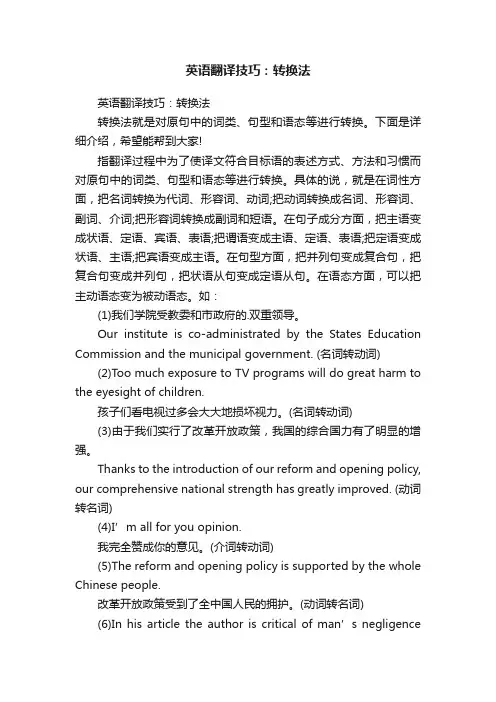
英语翻译技巧:转换法英语翻译技巧:转换法转换法就是对原句中的词类、句型和语态等进行转换。
下面是详细介绍,希望能帮到大家!指翻译过程中为了使译文符合目标语的表述方式、方法和习惯而对原句中的词类、句型和语态等进行转换。
具体的说,就是在词性方面,把名词转换为代词、形容词、动词;把动词转换成名词、形容词、副词、介词;把形容词转换成副词和短语。
在句子成分方面,把主语变成状语、定语、宾语、表语;把谓语变成主语、定语、表语;把定语变成状语、主语;把宾语变成主语。
在句型方面,把并列句变成复合句,把复合句变成并列句,把状语从句变成定语从句。
在语态方面,可以把主动语态变为被动语态。
如:(1)我们学院受教委和市政府的.双重领导。
Our institute is co-administrated by the States Education Commission and the municipal government. (名词转动词)(2)Too much exposure to TV programs will do great harm to the eyesight of children.孩子们看电视过多会大大地损坏视力。
(名词转动词)(3)由于我们实行了改革开放政策,我国的综合国力有了明显的增强。
Thanks to the introduction of our reform and opening policy, our comprehensive national strength has greatly improved. (动词转名词)(4)I’m all for you opinion.我完全赞成你的意见。
(介词转动词)(5)The reform and opening policy is supported by the whole Chinese people.改革开放政策受到了全中国人民的拥护。
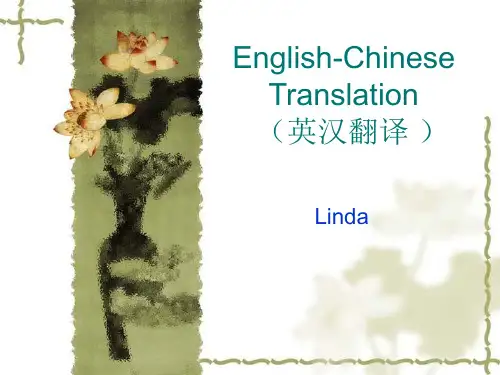
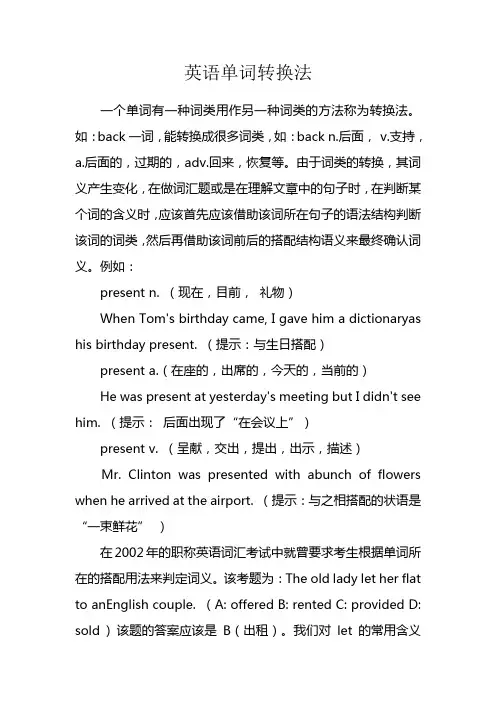
英语单词转换法一个单词有一种词类用作另一种词类的方法称为转换法。
如:back一词,能转换成很多词类,如:back n.后面,v.支持,a.后面的,过期的,adv.回来,恢复等。
由于词类的转换,其词义产生变化,在做词汇题或是在理解文章中的句子时,在判断某个词的含义时,应该首先应该借助该词所在句子的语法结构判断该词的词类,然后再借助该词前后的搭配结构语义来最终确认词义。
例如:present n. (现在,目前,礼物)When Tom's birthday came, I gave him a dictionaryas his birthday present. (提示:与生日搭配)present a.(在座的,出席的,今天的,当前的)He was present at yesterday's meeting but I didn't see him. (提示:后面出现了“在会议上”)present v. (呈献,交出,提出,出示,描述)Mr. Clinton was presented with abunch of flowers when he arrived at the airport. (提示:与之相搭配的状语是“一束鲜花”)在2002年的职称英语词汇考试中就曾要求考生根据单词所在的搭配用法来判定词义。
该考题为:The old lady let her flat to anEnglish couple. (A: offered B: rented C: provided D: sold ) 该题的答案应该是B(出租)。
我们对let的常用含义(让。
)和结构(let sb do sth./let's do sth.)很熟悉, 但可能就忽略了其“出租”的含义和用法(to let ahouse 出租房子)。
借助动词let的宾语“房子”可以在let 的注释词条中找到“出租”这一含义。